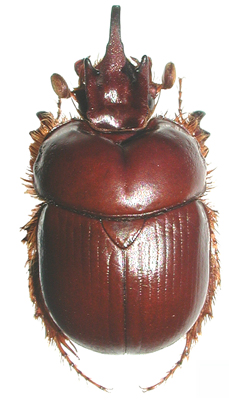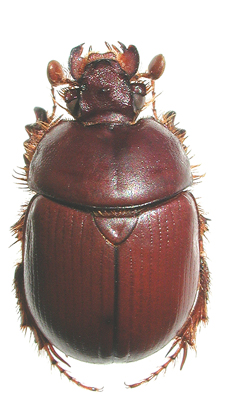| .. |
Scarabaeoidea of Southern South America Links
|
.
Keys |
|
| |
| .. |
Scarab Guide Links
(goes to the University of Nebraska
web site) |
.
Classification |
|
|
| |
|
| . |
.
Bolborhinum tricorne (Solier, 1851) |
| |

|
 |
male |
female |
Bolborhinum tricorne. |
| |
|
Bolborhinum tricorne, male. |
| |
|
Bolborhinum tricorne, female. |
| |
|
Distribution of Bolborhinum tricorne in southern South America. |
| |
|
...... |
Original combination. Bolboceras tricorne Solier, 1851: 67 (emended from Bolboceras tricornis).
Type locality: “la provincia de Santiago.”
Type series: lectotype male at MNHN labeled a) “Stago” (handwritten), b) “15 / 43” (handwritten on white underside of round, green label), c) “Bolboceras / tricornis Sol / Santiago.” (handwritten), d) “MUSEUM PARIS / CHILI / Gay 15-43” (typeset), e) “TYPE” (red label, typeset), “BOLBOCERAS / TRICORNE / SOLIER / LECTOTYPE m# / A.B.T. SMITH” (red label, handwritten and typeset), f) “Southern Neotropical Scarabs / database # AS2609489 / Bolborhinum tricorne / (Solier, 1851) m# / DET: A.B.T.SMITH 2007” (typeset). Lectotype designated by Mondaca and Smith (2008). One paralectotype (actually a specimen of Bolborhinum laesicolle not B. tricorne) at MNHN labeled: a) “15 / 43” (handwritten on white underside of round, green label), b) “Bolboceras / tricornis Sol” (handwritten), c) “MUSEUM PARIS / CHILI / Gay 15-43” (typeset), d) “Bolboceras / laesicolle Fairm.” (handwritten), “BOLBOCERAS / TRICORNE / SOLIER / PARALECTOTYPE / A.B.T. SMITH” (yellow label, handwritten and typeset), e) “Southern Neotropical Scarabs / database # AS2609502 / Bolborhinum laesicolle / (Fairmaire, 1856) / DET: A.B.T.SMITH 2007” (typeset). |
| |
...... |
| |
Specimens examined. 132 specimens were examined from AUPC, FMNH, GACC, HAHC, JEBC, JMEC, MEUC, MGAC, MNNC, SRTC, UCCC, UMCE, VMDC. |
| |
|
|
Diagnosis. Length 11.3-15.0 mm. Color reddish-brown or dark brown. This species is distinguished from other Bolborhinum by the shape, number, and placement of the male cephalic horns. Head dorsally with three horns, a large horizontal clypeal horn directed anteriorly and 2 large horns that originate at the ocular margin; first horn large, distally acute, basally widened or with two small horns situated to each side of the midline; second and third horn compressed, widened and truncate distally; dorsal surface with deep, large concavity occupying part of the frons and vertex (Figs. 30, 32). Pronotum convex, depressed medially, divided by furrow, without antero-medial excavation; pronotal disc impunctate medially, laterally with moderate-sized punctures, punctures moderately dense.
Females similar to males, except in the trapezoidal shape of the head and cephalic ornamentation; dorsal surface with a simple or bifid frontal tubercle variably developed, elevated, or obsolete; supraocular margin elevated, cariniform, arcuate posteriorly. Pronotum slightly depressed immediately behind of the apical margin, dorsally with medial furrow. Pronotal disc sparsely punctate with small punctures except near midline where punctures are moderately dense. |
| |
|
|
Distribution (Fig. 61). CHILE (132). IV Región de Coquimbo (1): Los Vilos, El Ñague (1). V Región de Valparaíso (8): Escuela Naval (1); Jardín Botánico (1); Limache (1); Marga Marga (1); Ocoa (1); Palmas de Ocoa (1); Punta de Tralca (1); Viña del Mar (1). Región Metropolitana de Santiago (97): Alhue (1); Cajón del Maipo (6); Caleu (12); Cerro El Roble (5); Curacaví, Lingues de Miraflores (2); El Canelo (17); El Manzano (17); El Peñón (8); El Peumo (1); La Obra (5); Melipilla (2); Pallocabe (1); Quebrada de Macul (1); Rangue, Aculeo (11); Río Clarillo (1); Río Maipo (2); Santiago (1); Santiago, 27 km SE (4). VI Región del General Bernardo O’Higgins (6): Doñihue, El Rulo (1); Las Cabras (1); Pichilemu (1); Reserva Nacional Río de Los Cipreses (3). VII Región del Maule (12): Linares (1); Llico (1); Parral (1); Potrero Grande (7); Radal (1); Vilches Alto (1). VIII Región del Biobío (7): Chiguayante (3); Concepción (1); Las Trancas (3). Country record (1). |
| |
|
|
Temporal data. January (3), February (1), March (1), July (1), August (2), September (22), October (31), November (53), December (17). |
| . |
|
| |
Excerpt from:
Mondaca, J. and A.B.T. Smith. (2008) A revision of the southern South American genus Bolborhinum Boucomont (Coleoptera: Geotrupidae: Bolboceratinae). Zootaxa, 1794, 1-48. |
| |
|

